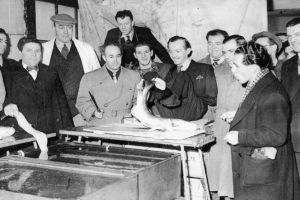Thomas John Ley (1880 — 1947) was an Australian politician who was convicted of murder in England. It is highly likely that he was also involved in the deaths of a number of people in Australia.

image found here
The Australian Minister for Justice became known as the Hanging Minister because of his enthusiasm for the death penalty. In fact, the evidence suggests that he was a serial killer.
Ley was a millionaire in his 60s. He had a mistress and owned properties across fashionable London. As a young man, he lied about his age, raising it so that he could marry a wealthy older woman named Lewie Vernon. When it came to social status, Ley was unstoppable.

Fashionable London 1920s found here
Not only did he lie about his age but he lied his way into the NSW Parliament. In 1917, he campaigned against the evils of alcohol and called himself ‘Lemonade Ley‘, as if he were the scourge of the publicans. And the voters fell for it. But once he got inside he sold them out. In fact, ‘Lemonade Ley’ was in the pay of a brewing company.

Lemonade Pie found here
By the mid-1920s, Ley was riding high, revelling in the privileges of a conservative politician. Appointed Minister for Justice, he earned hatred from both sides of politics with his brutal enthusiasm for capital punishment. State Labor leader Jack Lang wrote of Ley, “There were many times in the NSW Parliament when we believed he was not only mad, but bad.“

Hanging coffins found here
By 1925, Ley had his ambitions trained on the prime ministership of Australia and targeted the Federal seat of Barton. Ley’s campaign was to have deadly consequences for the man who held the seat, Labor’s Fred McDonald. He tried to bribe McDonald so that McDonald would effectively run dead in the election.

Fred McDonald found here
A defeated McDonald pursued Ley with allegations of bribery. But the wealthy Ley retaliated by threatening to ruin him with a defamation suit. McDonald backed down, he apologised and even, it was claimed, signed a document exonerating Ley. Then McDonald changed his mind. He would charge Ley with bribery after all. This placed Ley in a very sticky situation. But on 15 April 1926, his problem – Fred McDonald – simply disappeared.
Fred McDonald’s body was never found. Another politician, Hyman Goldstein, fell prey to T.J. Ley some months later. Ley had set up a company to rid Australia of prickly pear, the weed that threatened the nation’s farmers and graziers. Goldstein had invested heavily in a business scheme of Ley’s to manufacture poison but he didn’t realise just how poisonous the scheme – or scam – would become.

Read how Australia eradicated prickly pear here
The Prickly Pear company went bust. Ley had stolen the funds and spent the shareholders’ money on a holiday with his mistress. Shortly after, Hyman Goldstein left his Coogee home at twilight for a stroll up on the cliffs. But he never came home. He was found later at the bottom of Coogee cliffs, stone dead.

Coogee cliffs found here
Under pressure to disappear, Ley beat a hasty retreat to England. Stanley Bruce, the Prime Minister of Australia, assisted by writing letters of introduction for Ley to take with him. He left behind his long-suffering wife Lewie and took along his mistress Maggie Brook instead.
As the years passed, Ley grew fat and rich. But then, sexual jealousy brought him unstuck. Ley became so delusional that he accused Maggie of having an affair with John Mudie, a barman half her age. Mad with jealousy, he paid to have Mudie kidnapped and killed.
When Mudie’s body was discovered in a chalk pit, the media went into a frenzy, with eager journalists digging up every last detail of Ley’s public life back in Australia. It had the sex angle: he had wealth, he had a mistress, he had a wife, he’d been a politician and he was a murderer. Front-page news right through the trial.
Ley denied the charges to the end. At the last minute, his death sentence was commuted on the grounds that he was insane. A petition from Australia probably helped his cause. The ‘Hanging Minister’ escaped the gallows.

Roof of the Gallows by Laszlo Baranyai found here































































